flat tire CHEVROLET S10 1993 2.G Owners Manual
[x] Cancel search | Manufacturer: CHEVROLET, Model Year: 1993, Model line: S10, Model: CHEVROLET S10 1993 2.GPages: 356, PDF Size: 20.85 MB
Page 7 of 356
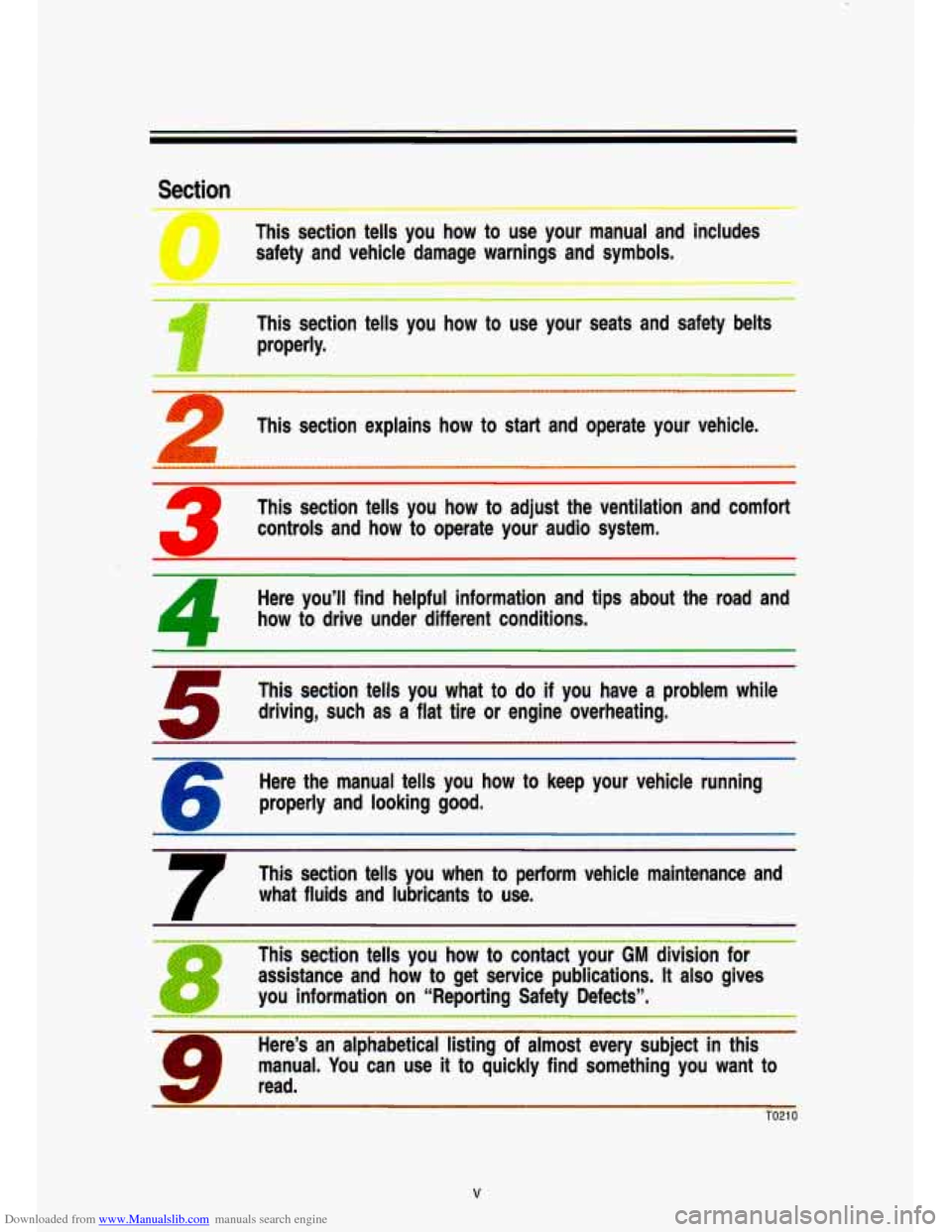
Downloaded from www.Manualslib.com manuals search engine Section
I
This section tells you how to use your manual and includes
safety and vehicle damage warnings and symbols.
‘II
This section tells you how to use your seats and safety belts
1 properly.
This section explains how to start and operate your vehicle.
’ This section tells you how to adjust the ventilation and comfort
controls and how to operate your audio system,
Here you’ll find helpful information and tips about the road and
how to drive under different conditions.
This section tells you what to
do if you have a problem while
driving, such as a
flat tire or engine overheating.
’ Here the manual tells you how to keep your vehicle running
properly and looking good.
7
This section tells you when to perform vehicle maintenance and
what fluids and lubricants to use.
~ ~~~~~ ~ ~ ~
1 This section tells you how to contact your GM division for
assistance and how to get service publications.
It also gives
you information on “Reporting Safety Defects”,
Here’s an alphabetical listing of almost every subject in this
I manual. You can line it to quickly find something you want to
Illrcl. read.
TO21 0
V
Page 177 of 356
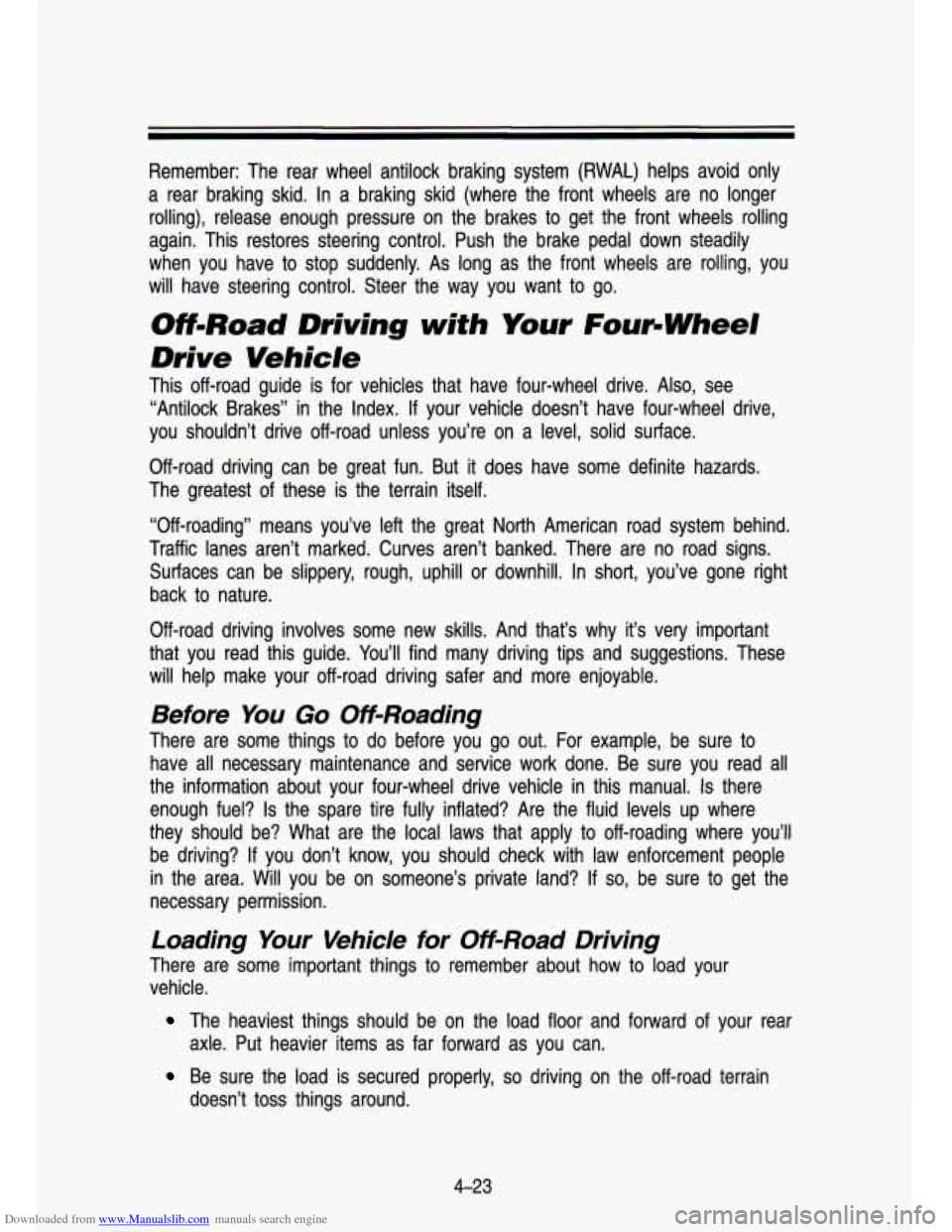
Downloaded from www.Manualslib.com manuals search engine Remember: The rear wheel antilock braking system (RWAL) helps \
avoid only
a rear braking skid. In a braking skid (where the front wheels \
are no longer
rolling), release enough pressure on the brakes to get the front wheels rolling
again. This restores steering control. Push the brake pedal dow\
n steadily
when you have to stop suddenly. As long as the front wheels \
are rolling, you
will have steering control. Steer the way you want to go.
Off-Road Driving with Your FoutNVheel
Drive Vehick
This off-road guide is for vehicles that have four-wheel drive.\
Also, see
“Antilock Brakes’’ in the Index.
If your vehicle doesn’t have four-wheel drive,
you shouldn’t drive off-road unless you’re on a level, so\
lid surface.
Off-road driving can be great fun. But it does have some definite hazards.
The greatest of these is the terrain itself.
“Off-roading” means you’ve left the great North American\
road system behind.
Traffic lanes aren’t marked. Curves aren’t banked. There a\
re no road signs.
Surfaces can be slippery, rough, uphill or downhill. In short, \
you’ve gone right
back to nature.
Off-road driving involves some new skills. And that’s why it’s very important
that you read this guide. You’ll find many driving tips and suggestio\
ns. These
will help make your off-road driving safer and more enjoyable. \
Before You Go Off-Roading
There are some things to do before you go outi For example, be sure to
have all necessary maintenance and service work done. Be sure \
you read all
the information about your four-wheel drive vehicle in this man\
ual.
Is there
enough fuel?
Is the spare tire fully inflated? Are the fluid levels up where
they should be? What are the local laws that apply to off-roading where you’ll
be driving?
If you don’t know, you should check with law enforcement people\
in the area. Will you be on someone’s private land?
If so, be sure to get the
necessary permission.
Loading Your Vehicle for Off-Road Driving
There are some important things to remember about how to load your
vehicle.
The heaviest things should be on the load floor and forward of your rear
Be sure the load is secured properly, so driving on the off-road terrain
axle. Put heavier items as far forward as you can.
doesn’t toss things around.
4-23
Page 198 of 356
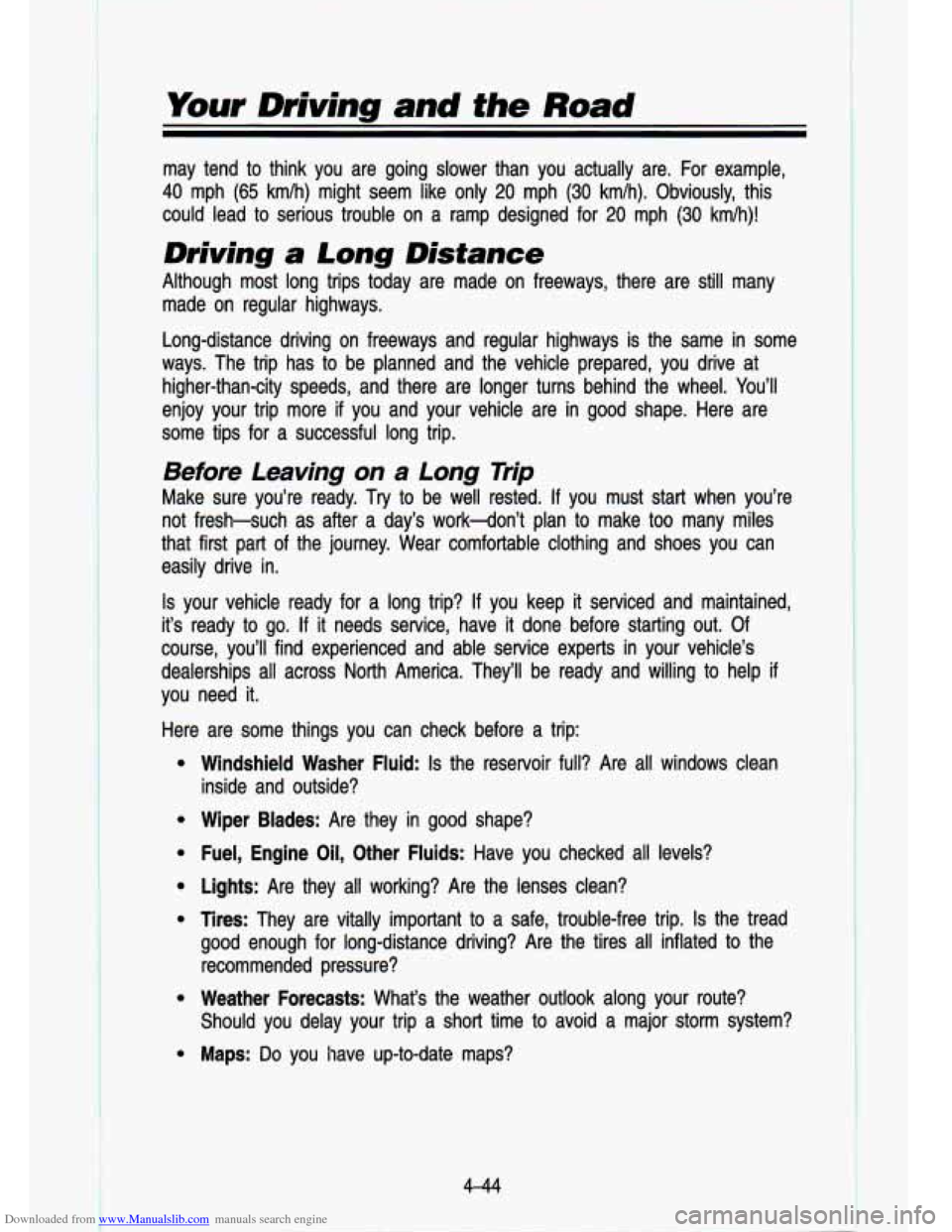
Downloaded from www.Manualslib.com manuals search engine Your Driving and the Road
..
C. .-, - ._ .
may tend to think you are going slower than you actually are.\
For example,
40 mph (65 km/h) might seem like only 20 mph (30 km/h). Obviously, this
could lead to serious trouble on a ramp designed for
20 mph (30 km/h)!
Driving a Long Distance
Although most long trips today are made on freeways, there are\
still many
made on regular highways.
Long-distance driving on freeways and regular highways is the s\
ame in some
ways. The trip has to be planned and the vehicle prepared, yo\
u drive at
higher-than-city speeds, and there are longer turns behind the \
wheel. You’ll
enjoy your trip more if you and your vehicle are in good shape. Here are
some tips for a successful long trip.
Before Leaving on a Long Trip
Make sure you’re ready. Try to be well rested. If you must start when you’re
not fresh-such as after a day’s work-don’t plan to make too many miles
that first part of the journey. Wear comfortable clothing and shoes you can
easily drive in.
Is your vehicle ready for a long trip? If you keep it serviced and maintained,
it’s ready to go.
If it needs service, have it done before starting out. Of
course, you’ll find experienced and able service experts in \
your vehicle’s
dealerships all across North America. They’ll be ready and w\
illing to help
if
YOU
Her1
0
need it.
ire
Some things you can check before a trip:
Windshield Washer Fluid:
Is the reservoir full? Are all windows clean
inside and outside?
Wiper Blades: Are they in good shape?
Fuel, Engine Oil, Other Fluids: Have you checked all levels?
Lights: Are they all working? Are the lenses clean?
Tires: They are vitally important to a safe, trouble-free trip.\
Is the tread
good enough for long-distance driving? Are the tires all inflat\
ed to the
recommended pressure?
Weather Forecasts: What’s the weather outlook along your rout\
e? Should you delay your trip
a short time to avoid a major storm system?
Maps:
Do you have up-to-date maps?
4-44
Page 200 of 356
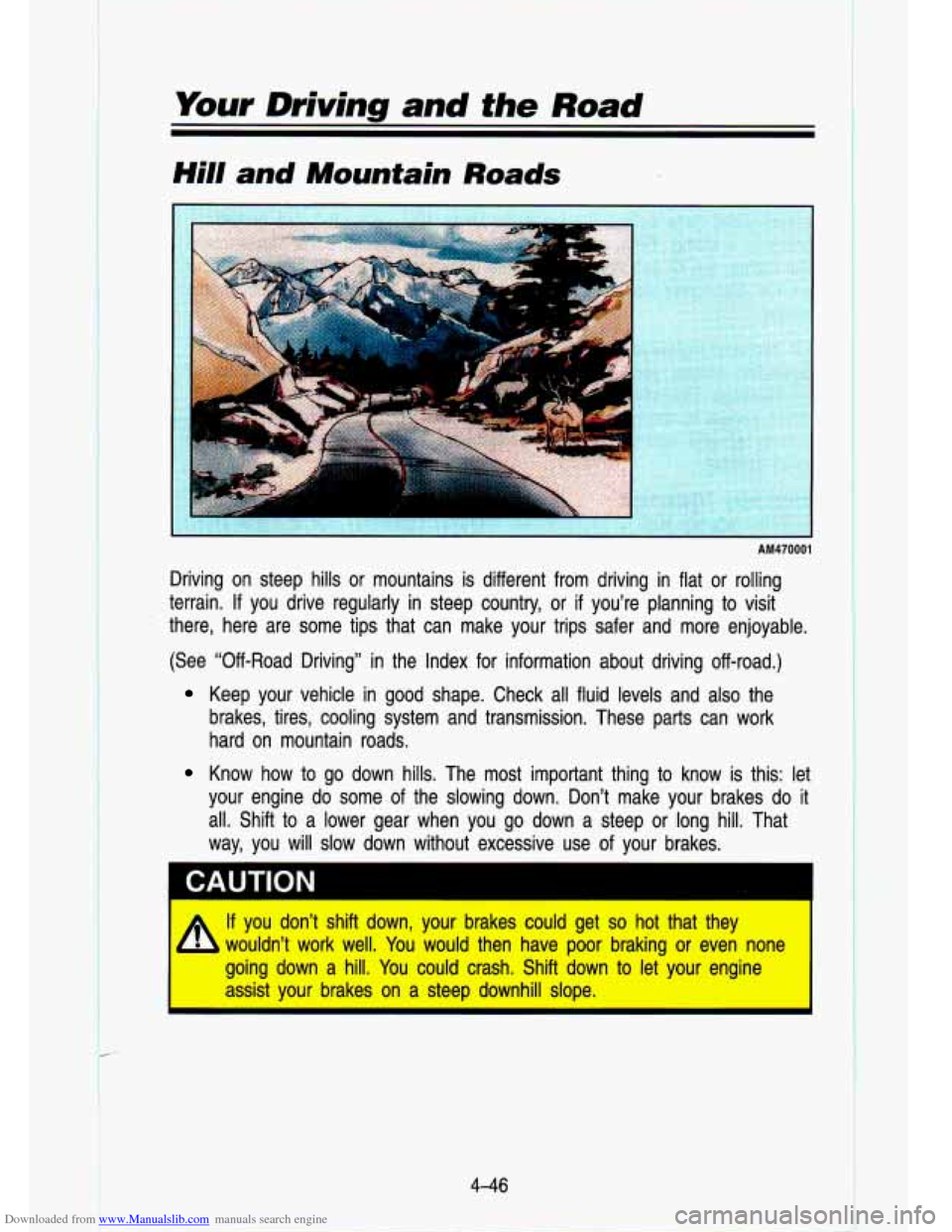
Downloaded from www.Manualslib.com manuals search engine . li 7. --
._ . .-
. .1 ..
Your Driving and the Road
Hill and Mountain Roads
I
AM470001
Driving on steep hills or mountains is different from driving in flat or rolling
terrain.
If you drive regularly in steep country, or if you're planning to visit
there, here are some tips that can make your trips safer and \
more enjoyable.
(See "Off-Road Driving" in the Index for information about driving off-road.)
Keep your vehicle in good shape. Check all fluid levels and also the
brakes, tires, cooling system and transmission. These parts can \
work
hard on mountain roads.
Know how to go down hills. The most important thing to know is this: let
your engine do some of the slowing down. Don't make your brak\
es do
it
all. Shift to a lower gear when you go down a steep or long hill. That
way, you will
slow down without excessive use of your brakes.
If you don't shift down, your brakes could get
so hot that they
wouldn't work well. You would then have poor braking or even none
going down a hill. You could crash. Shift down to let your engine
1 assist your brakes on a steep downhill slope.
4-46
Page 212 of 356
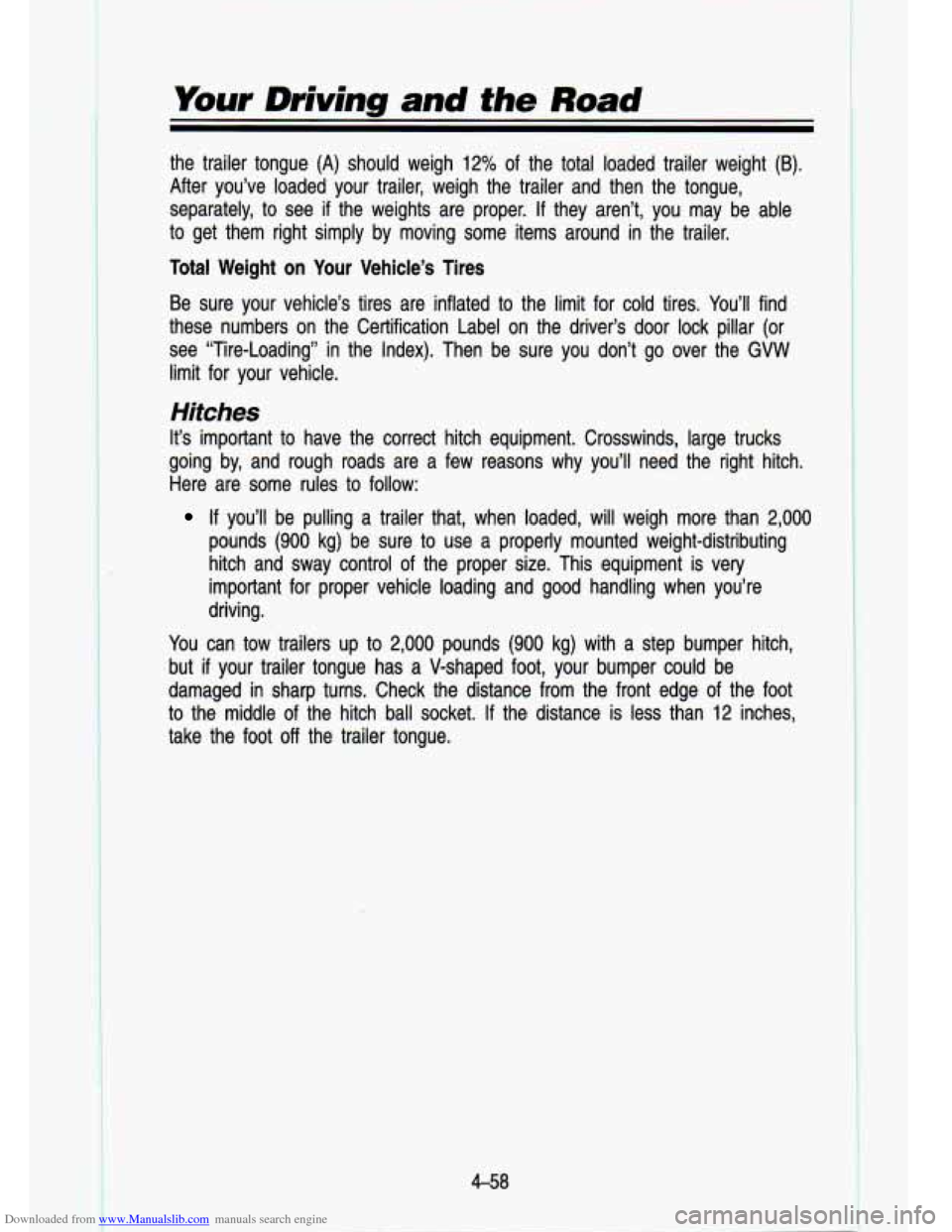
Downloaded from www.Manualslib.com manuals search engine Your Driving and the Road
the trailer tongue (A) should weigh 12% of the total loaded trailer weight (B).
After you’ve loaded your trailer, weigh the trailer and then\
the tongue,
separately,
to see if the weights are proper. If they aren’t, you may be able
to get them right simply by moving some items around in the trai\
ler.
Total Weight
on Your Vehicle’s Tires
Be sure your vehicle’s tires are inflated
to the limit for cold tires. You’ll find
these numbers on the Certification Label on the driver’s doo\
r lock pillar (or see “Tire-Loading” in the Index). Then be sure you don’\
t go over the GVW
limit for your vehicle.
Hitches
It’s important to have the correct hitch equipment. Crosswind\
s, large trucks
going by, and rough roads are a few reasons why you’ll need the right hitch.
Here are some rules to follow:
If you’ll be pulling a trailer that, when loaded, will weigh more than 2,000
pounds (900 kg) be sure to use a properly mounted weight-distributing
hitch and sway control
of the proper size. This equipment is very
important for proper vehicle loading and good handling when you\
’re
driving.
You can tow trailers up to
2,000 pounds (900 kg) with a step bumper hitch,
but
if your trailer tongue has a V-shaped foot, your bumper could be
damaged in sharp turns. Check the distance from the front edge of the fo\
ot
to the middle of the hitch ball socket. If the distance is less than 12 inches,
take the foot
off the trailer tongue.
Page 217 of 356
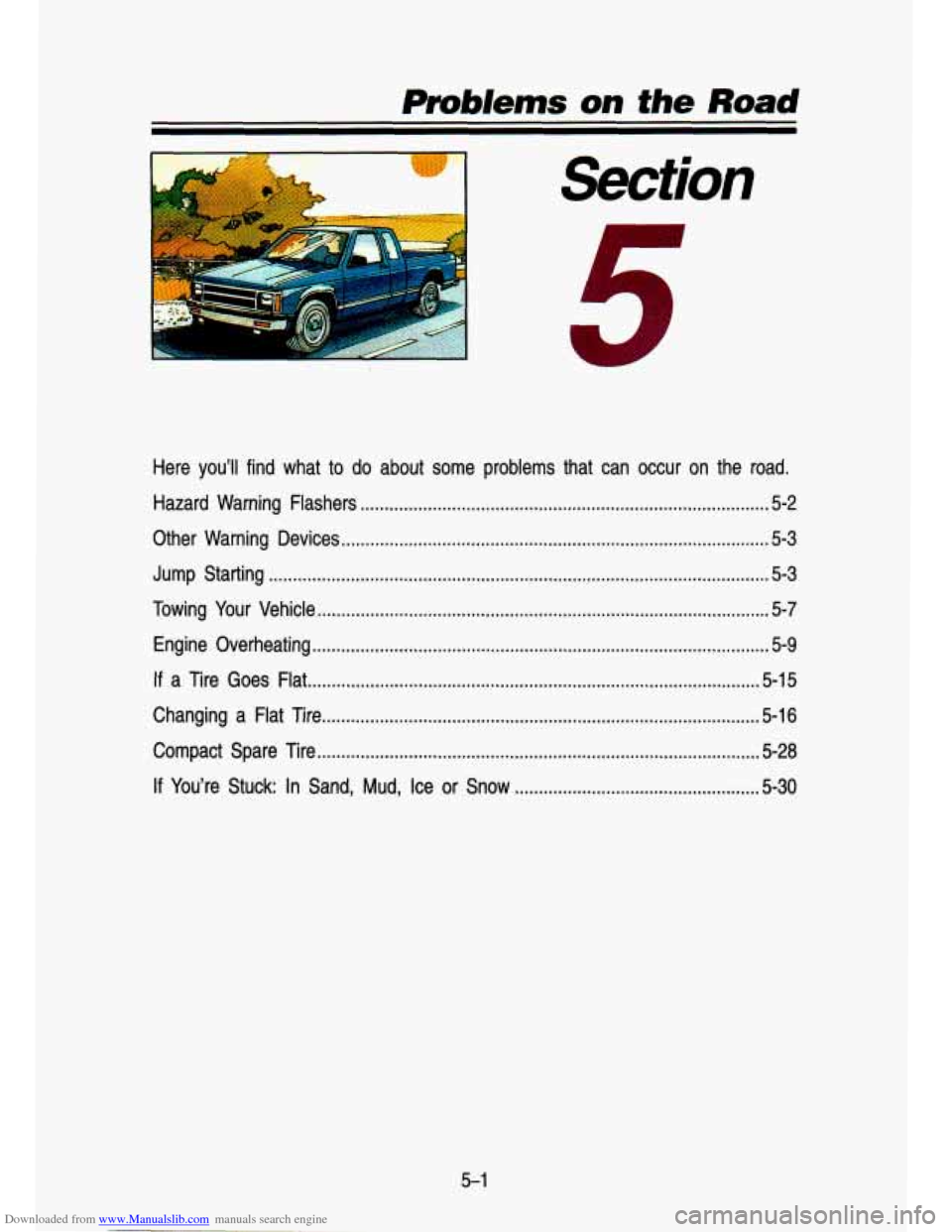
Downloaded from www.Manualslib.com manuals search engine prOb/ems on the Road
. .-
r
7
Here you’ll find what to do about some problems that can occur on the road .
Hazard Warning Flashers ........................................................................\
............. 5-2
Other Warning Devices ........................................................................\
................. 5-3
Jump Starting ........................................................................\
................................ 5-3
Towing Your Vehicle ........................................................................\
...................... 5-7
Engine Overheating ........................................................................\
....................... 5-9
If a Tire Goes Flat ........................................................................\
...................... 5-15
Changing a Flat Tire ........................................................................\
................... 5-16
Compact Spare Tire ........................................................................\
.................... 5-28
If You’re Stuck: In Sand, Mud, Ice or Snow ................................................... 5-30
Page 231 of 356
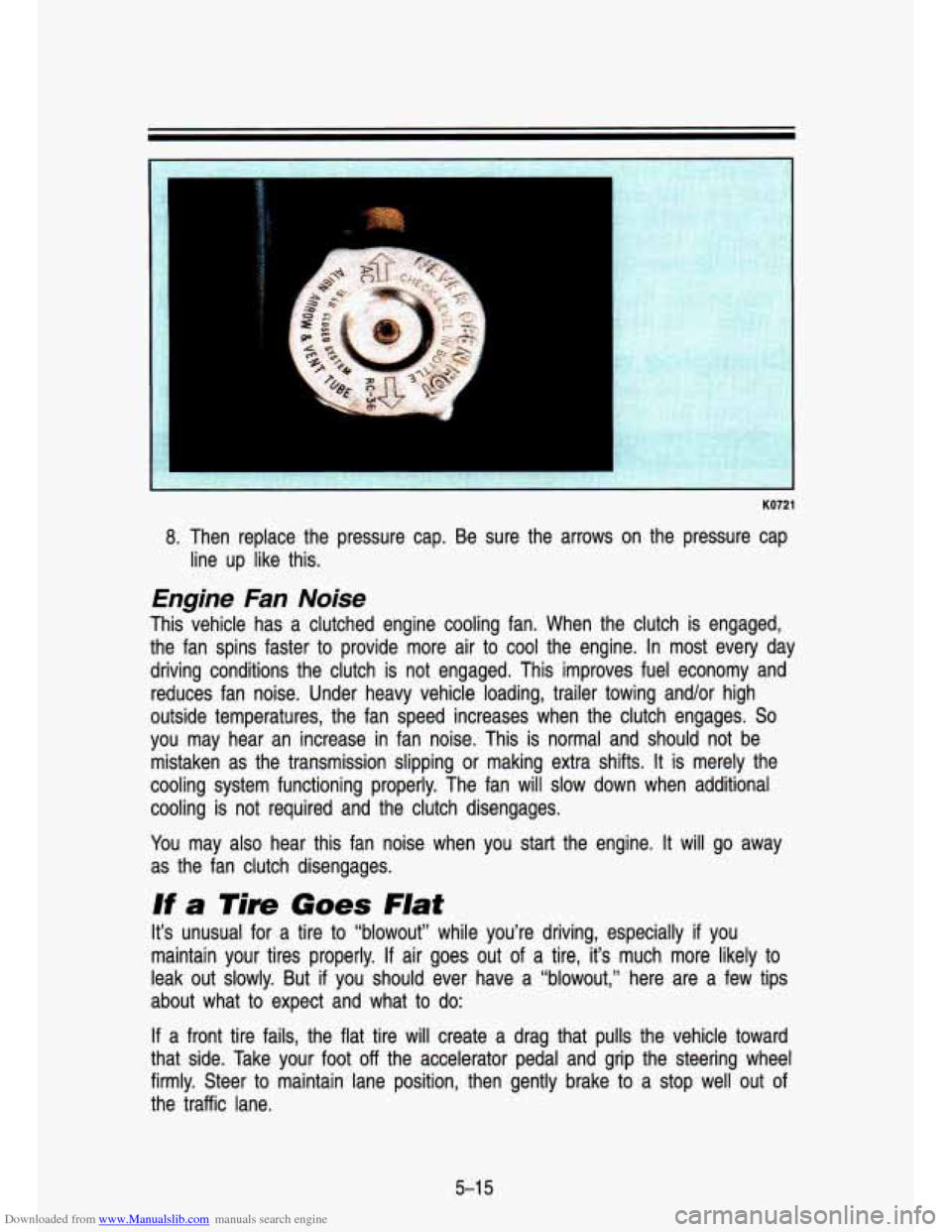
Downloaded from www.Manualslib.com manuals search engine KO721
8. Then replace the pressure cap. Be sure the arrows on the pres\
sure cap line up like this.
Engine Fan Noise
This vehicle has a clutched engine cooling fan. When the clutch is engaged,
the fan spins faster to provide more air to cool the engine. In most every day
driving conditions the clutch is not engaged. This improves fue\
l economy and
reduces fan noise. Under heavy vehicle loading, trailer towing andlor high
outside temperatures, the fan speed increases when the clutch e\
ngages.
So
you may hear an increase in fan noise. This is normal and should not be
mistaken as the transmission slipping or making extra shifts.
It is merely the
cooling system functioning properly. The fan will slow down whe\
n additional
cooling is not required and the clutch disengages.
You may also hear this fan noise when you start the engine. It will go away
as the fan clutch disengages.
If a Tire Goes Flat
It’s unusual for a tire to “blowout” while you’re d\
riving, especially if you
maintain your tires properly.
If air goes out of a tire, it’s much more likely to
leak out slowly. But if you should ever have a “blowout,”\
here are a few tips
about what to expect and what to do:
If a front tire fails, the flat tire will create a drag that pu\
lls the vehicle toward
that side. Take your foot off the accelerator pedal and grip the steering wheel
firmly. Steer to maintain lane position, then gently brake to \
a stop well out of
the traffic lane.
5-1 5
Page 232 of 356
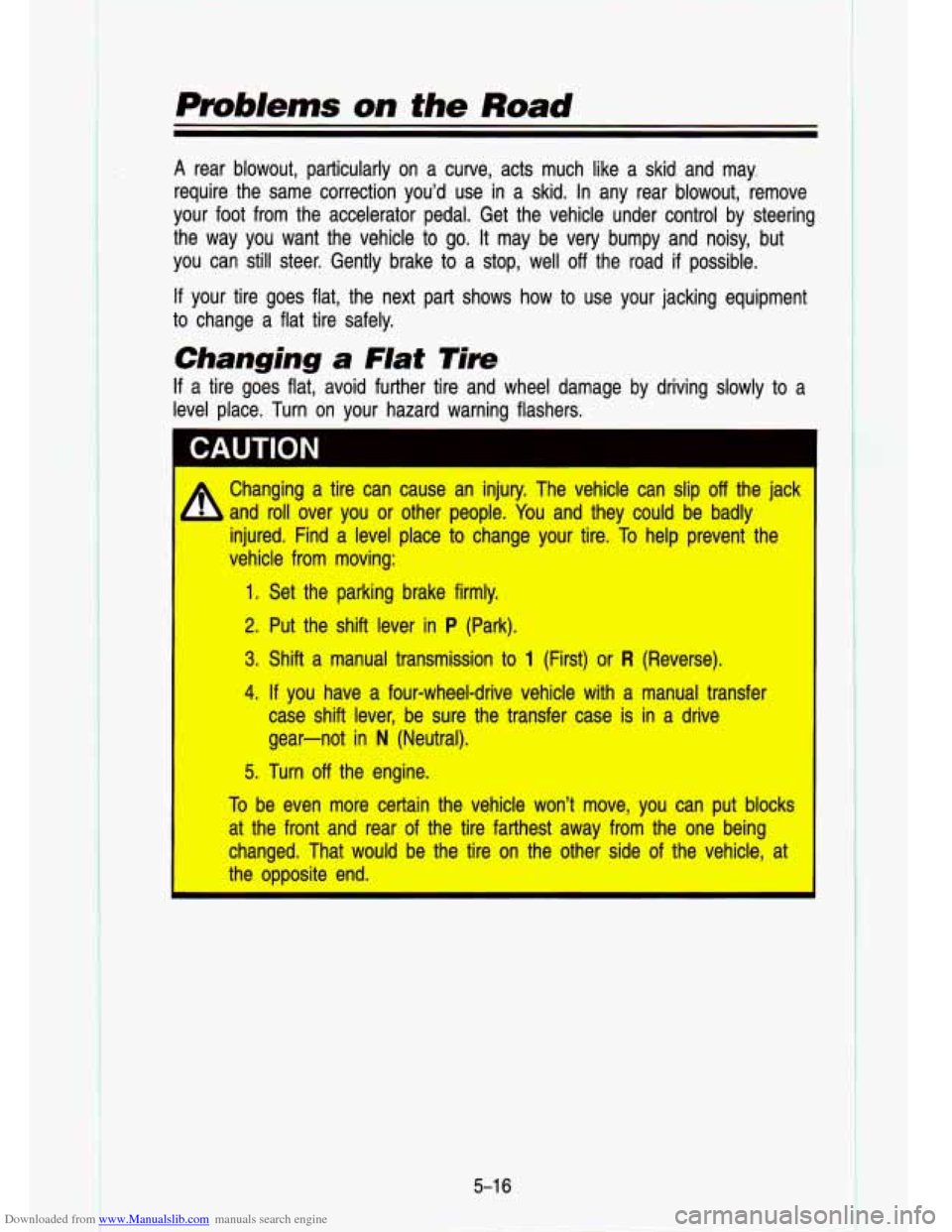
Downloaded from www.Manualslib.com manuals search engine Problems on the Road
A rear blowout, particularly on a curve, acts much like a skid and may,
require the same correction you'd use in a skid. In any rear blowout, remove
your foot from the accelerator pedal. Get the vehicle under co\
ntrol by steering
the way you want the vehicle
to go. It may be very bumpy and noisy, but
you can still steer. Gently brake
to a stop, well off the road if possible.
If your tire goes flat, the next part shows how to use your jac\
king equipment
to change a flat tire safely.
Changing a Flat Tire
If a tire goes flat, avoid further tire and wheel damage by driving slowly to a
level place. Turn on your hazard warning flashers.
I CAUTION I
A Changing a tire can cause an injury. The vehicle can slip off the jack
A and roll over you or other people. You and they coulld be badly
injured. Fin'd a level place to change your tire. To help prevent the
vehicle from moving:
I. Set the parking brake firmly.
2. Put the shift lever in P (Park).
3. Shift a manual transmission to 1 (First) or R (Reverse).
4. If you have a four-wheel-drive vehicle with a manu'al transfer
case
shift lever, be sure the transfer case is in a drive
gear-not
in ' N (Neutral).
5- Turn off the engine.
To be even more certain the. vehick won't move, you can put blocks
at
the front and rear of the tire farthest away from the one being
changed. That would be the tire
on the other side of the vehicle, at
the opposite end.
5-1 6
Page 237 of 356
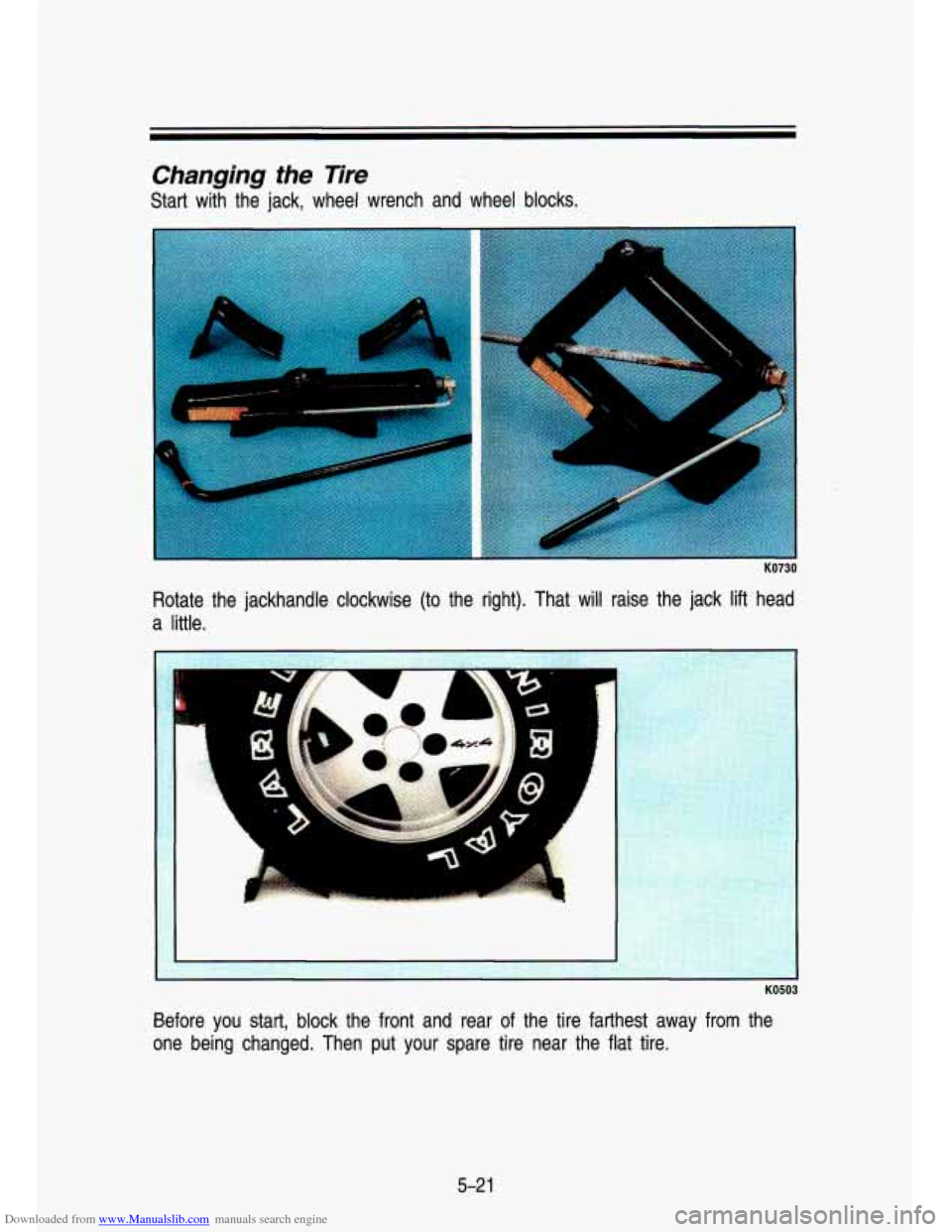
Downloaded from www.Manualslib.com manuals search engine Changing the Tire
Start with the jack, wheel wrench and wheel blocks. Rotate the jackhandle clockwise (to the right). That, will ra\
ise the jack lift head
a little.
F
F
I
KO503
Before you start, block the front and rear of the tire farthest away from the
one being changed. Then put your spare tire near the flat tire.
5-2 1
Page 239 of 356
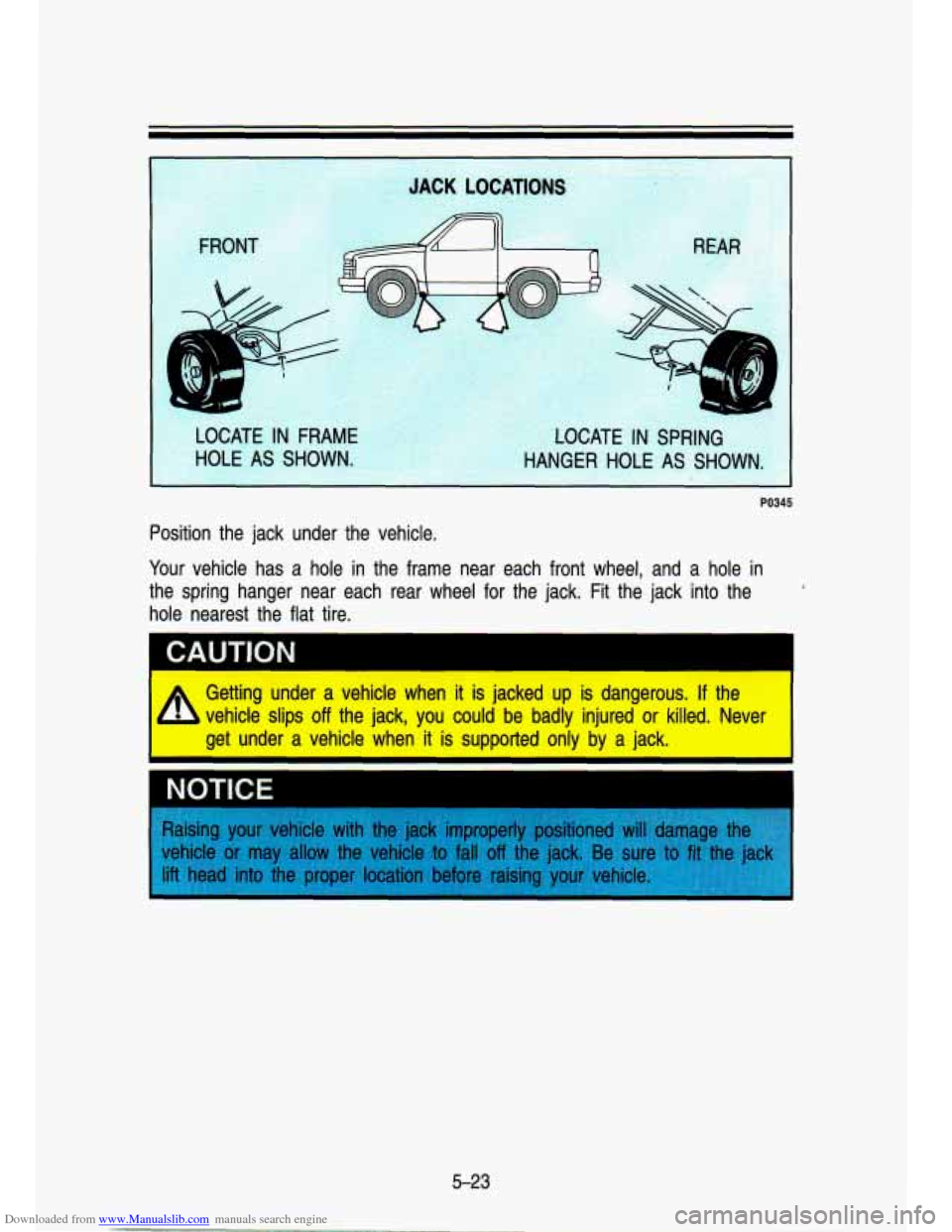
Downloaded from www.Manualslib.com manuals search engine PO345
Position the jack under the vehicle.
Your vehicle has a hole in the frame near each front wheel, and a\
hole in
the spring hanger near each rear wheel for the jack. Fit the \
jack into the
hole nearest the flat tire.
I CAUTION
If the 1 Getting under a vehicle when it is jacked up is dangerous.
vehicle slips
off the jack, you could be badly injured or killed. Never
get under a vehicle when it is supported only
by a jack.
5-23